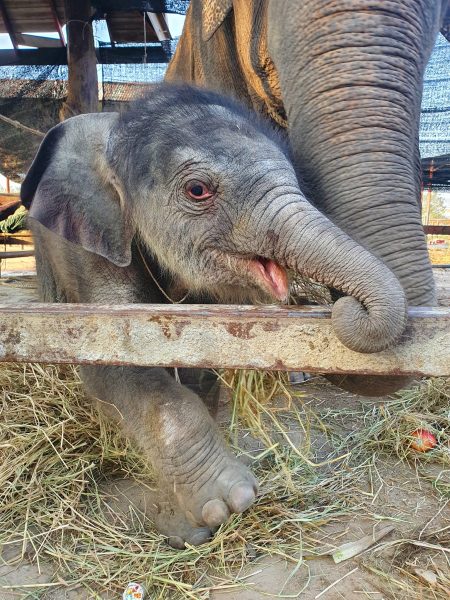Births 2022
Birth No. 84 – 6 January 2022
Buannoi had her fourth baby a boy, born at 4.45am. Covid is not stopping us from making sure elephants live into the future for generations to come
Our 84th baby is named Plai Hatsadin: After The Elephant-bird that Built the Civilisation of the North.
“Hatsadin”, which comes from the root word ‘hatsadi’, is the name of a giant elephant-bird that has featured in the arts and traditions of the Lanna Region of northern Thailand for at least 1,400 years. (It’s most likely much longer than that, but it appears the known historical records date back to only 1,400 years.) The ‘hatsadin’ elephant-bird is also known as ‘hatsadiling’, a more commonly used name of the same root word. The ‘hatsadin’ has the head and body of a lion, the trunk and tusks of an elephant, the wings of a bird, the tail of a phoenix, and the strength and power of five primordial Erawan elephants (also known as ‘Airavata’, the elephant of both Heaven and Earth). The life of a ‘hatsadin’ is one of service, since the elephant-bird’s role is that of ambassador, messenger, carrier, and deliverer who flies between dimensions.
The most widespread myth of the ‘hatsadin’ tells of the founding figures of an ancient civilisation called Hariphunchai, home of the Mon people located in present-day northern Thailand. (According to the remaining archaeological evidence, the Hariphunchai Kingdom, believed to be founded in the year 629 AD, covers the present-day provinces of Lamphun and Chiang Mai, more precisely the Chiang Mai districts of Hangdong, Jomthong, and Sanpatong.) A discussion took place between three ‘rishi’ hermits — Wa Suthep Dabot of Doi Suthep Mountain (located in present-day Chiang Mai), Sukkatanta of the Lavo Kingdom (located in present-day Lopburi), and another hermit called Anusisa. The hermits planned to build a city called Hariphunchai, and to design the exterior of that city into an overall form resembling a conch shell (also known as the ‘shankha’ shell which has a role of ritualistic importance in Hinduism). The hermits then called a ‘hatsadin’ elephant-bird to come out from the forested mountains, and instructed the hatsadin to fly over the ocean and find a suitable conch shell that would form the model of the Hariphunchai city layout.
Once the hatsadin flew back with the conch shell, the hermits used their walking sticks to draw the outline of the Hariphunchai city plan according to the shape of the conch shell. These efforts to shape the city into a shell form led to the city having a central mound resembling a turtle shell, with a surrounding river.
As you know we put great emphasis on the names of our elephants to reflect the culture and history of Thailand and give them the significance and meaning they deserve in this world. Thank you to Lalipa Nilubol for this excellent translation and information.

